SDS Server
Strike Design Studio
Project
SDS Server is a website hosting community! Inspired by community webrings, directories and cybercafes of the early web, it seeks to expose the web we use every day - by making internet with your own two hands. On this server, participants will build and upload their own websites, making open calls for submissions, inviting artists, designers, writers, workers, and hackers to publish work on the server and use hosting as a tool for community building, sharing resources, and a directory for distribution.
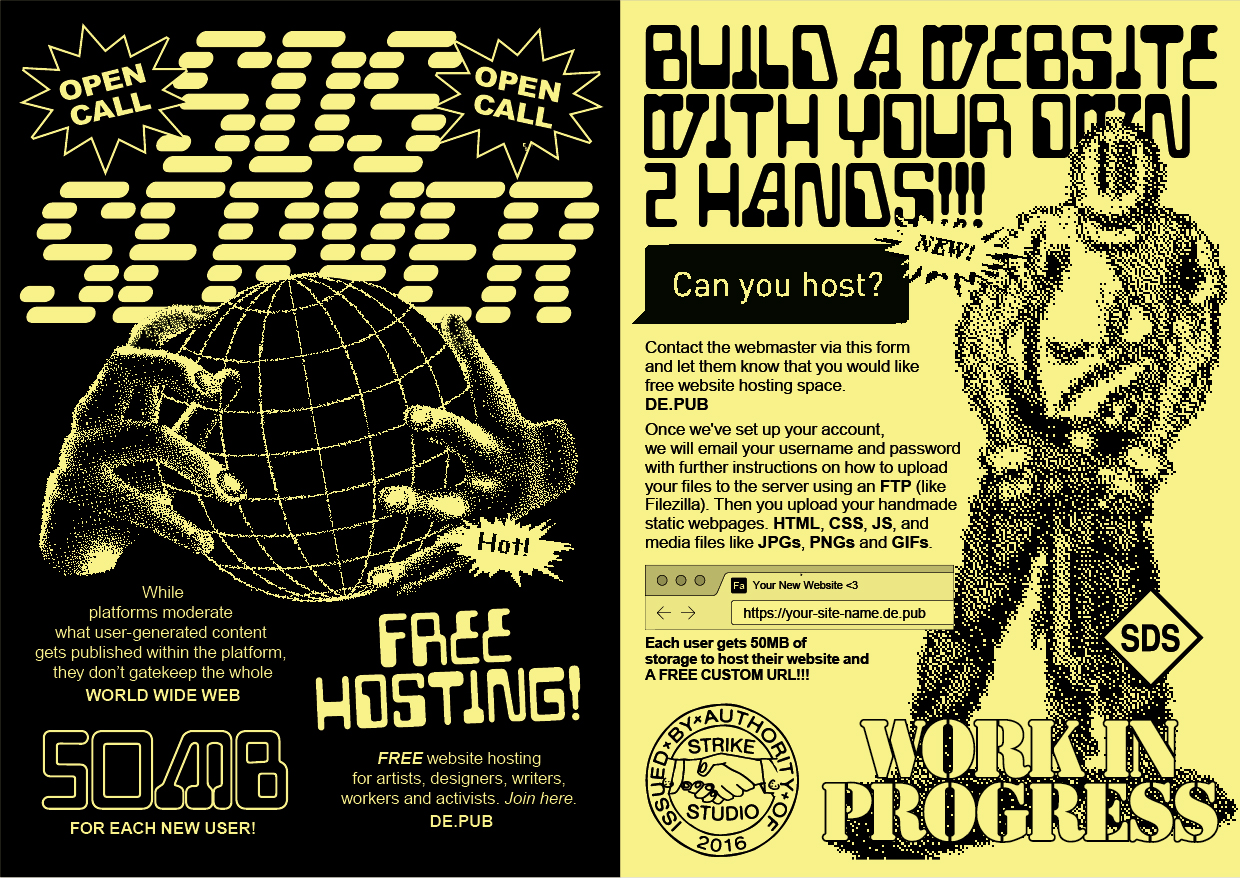
About Me
I currently work as a website publisher, providing website design services and already hosting client websites. I've also been working on a manual and audiobook on the history of websites, how the web works, how to make a site, and its potential. The Website Owner's Manual is inspired by The Politics of Design by Ruben Pater, D.I.Y. Manuals like the "for Dummies" series and the Whole Earth Catalog. Manuals are political texts that empower readers with the knowledge to repair the web (The unlikely political and cultural power of the DIY Manual).
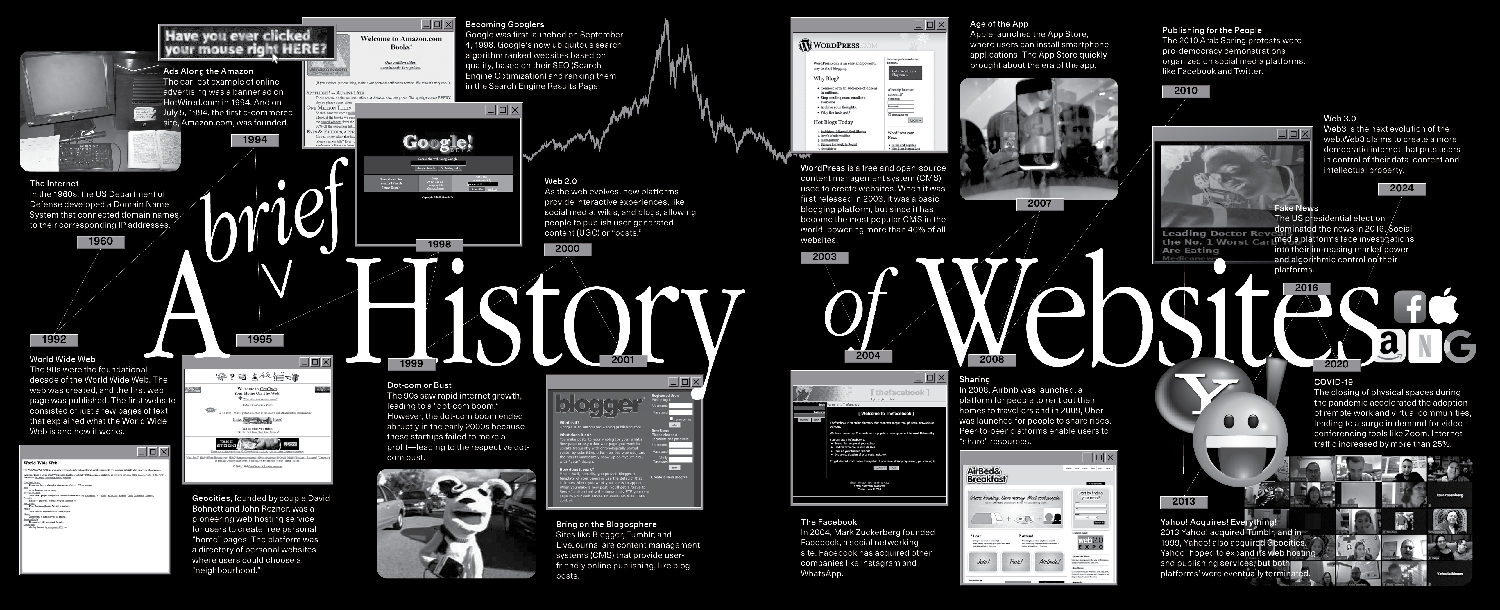
The Two Revolutions
I'm inspired by The Two Revolutions - which highlights the importance of trans-owned and governed web and for trans autonomy on an increasingly moderated web. In this, they reference a business called Creative Design Services (cdspub.com) run by "CyberQueen" JoAnn Roberts and offered free community webpages called the "community center." CDS supported TGForum.com and other publications in her "Bookstand" (page header captured below from 1996 of the queen herself). The book covers how trans people exploited digital infrastructures, building webrings and directories in the early days of the internet to build community and continue to inform today's social web.

Homepages
I am borrowing from the design language of this first generation of hosting providers (soon-to-be platforms) like cdspub.com, gurl.com, and GeoCities. The founders of Geocities, David Bohnett and John Rezner, sought to combine their software careers with their LGBT activism. David Bohnett developed GeoCities.com to "give people a voice and a chance to meet like-minded people." Geocities was one of the first web hosting services that allowed users to create and publish websites for free - foreshadowing MySpace and Facebook. Turning the new web into a virtual neighbourhood where users pick an “address” within the GeoCities virtual neighbourhood to create their website. Instead of viewing the web as a platform, it’s a home.

CyberCafe
The founder of Geocities later funded CyberCenters – internet cafes where queer people find support, resources, computers, and internet access. Similarly, local print shops provide the local public with tools for printing, filing paperwork, faxing documents, and making community flyers. These spaces are less structured and have fewer rules, subverting regulation and moderation by the nature of their scale. They are also interactive, flexible, and imperfect. Sometimes, they go out of business. I want to later turn the Website Owners ManualxSDS Server into a travelling internet cafe - adjacent to zine-making workshops, using this server as community infrastructure.
"The shop is a space of public pedagogy, an “operating theater” where the repairman opens gadgets, demonstrates technical skills, and perhaps encourages observers to mend rather than discard their own broken things" (Maintenance and Care: Fixing a Broken World).
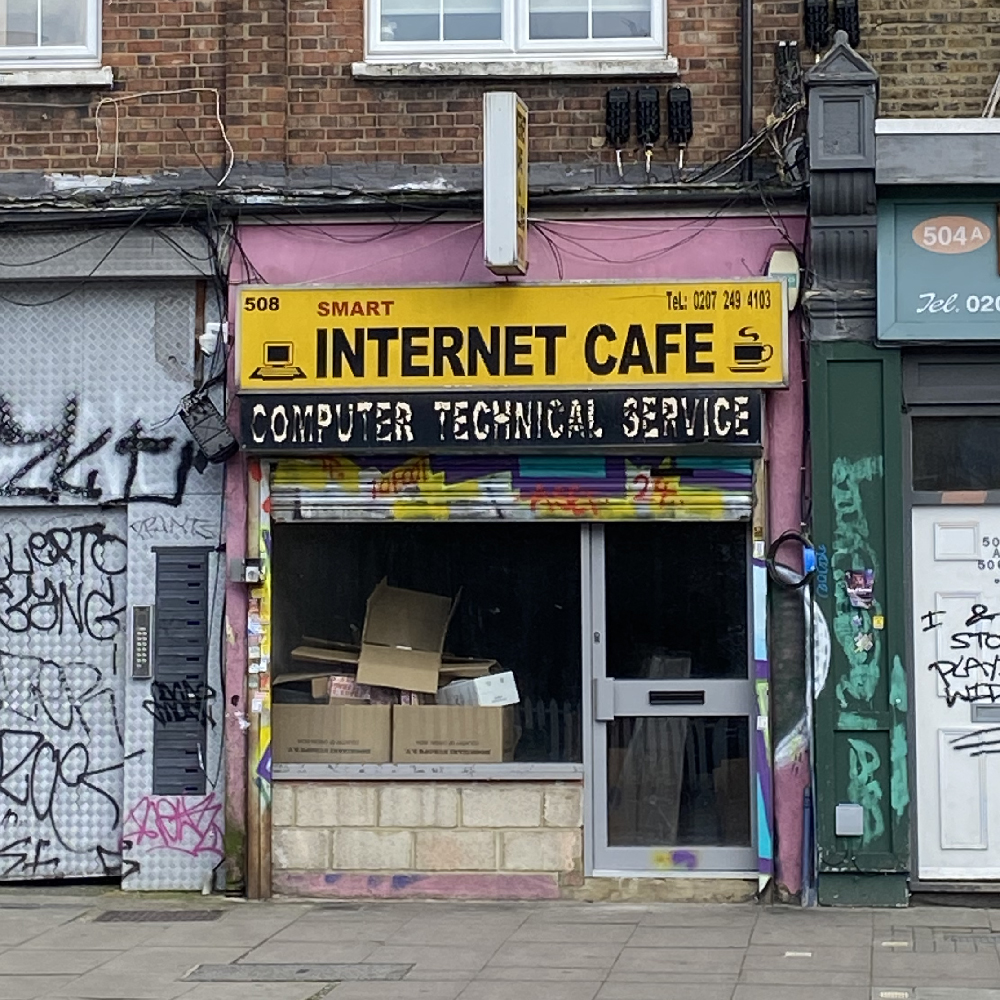
Pages to Platforms
Gurl.com was initially launched as a print zine before becoming a website publishing platform, a forum, and a free shared web hosting service where members could publish 'handmade' static webpages. Demonstrating a "correlation between handmade web pages and handmade print materials, such as zines, pamphlets, and artists' books" (A Handmade Web). Gurl.com was later acquired, and a Tumblr post reflects, "The architecture of the site itself prevents new forms of self-discovery and communication from happening because it does not provide the proper tools.” During this transition, "service providers took many actions to reduce and restrict: rewriting Terms of Service (ToS) and taking away frameworks," and relegating today's "homeless" platform users to squatting on servers with regressive and restrictive software (Interface Critique: From My to Me).
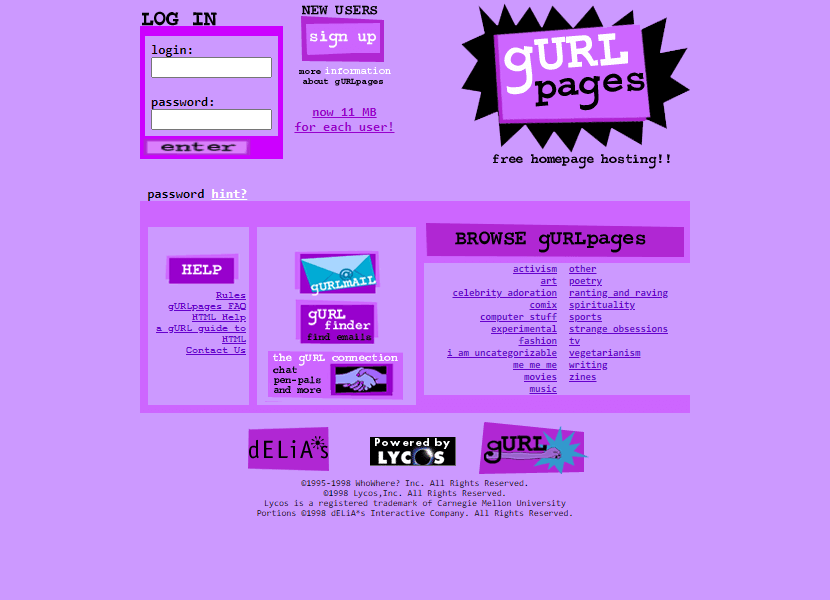
The Handmade Web
The handmade web describes "web pages coded by hand rather than by software; web pages made and maintained by individuals rather than by businesses or corporations; web pages that are provisional, temporary, or one-of-a-kind; and web pages that challenge conventions" and "draw attention both to the manual labour involved in the composition of web pages, and the functioning of the web page itself as a 'manual', a 'handbook', a set of instructions required for a computer program to run." (A Handmade Web) This "reimagination invites us to roll-up our sleeves" to "feel the heat of the processor, hear the speed and power of the disc drive whirling, and see what files are taking up the space," in this process, we are "opening up the seams and scars of technology, we show how much communities are 'infrastructuring' and realising continuous co-creation to reclaim agency, knowledge, and power through a visceral relationship with the Internet." (A Feminist Server Stack: co-designing feminist web servers to reimage Internet futures).

Software
The web is described as "a soft world in a different sense, in the original sense of the word: it changes its shape easily" (What Screens Want). Crafting this software, malleable like clay, allows us to "imagine that nothing in the world is fixed and that the limits of repair, replacement, restoration and construction are the limits of one’s ability, imagination, ingenuity or agency" (Craft permitted me to imagine that nothing in the world is fixed). This is the "queer potential of the Internet, of any space where the body can be remade," (Watching Hackers in 2017) because "Computers, after all, are just shaky towers of nested abstractions," (What Screens Want).
"hear the chatter of pneumatic drills, the drone of street sweepers, and, in the city’s peripheral zones, the clang and hydraulic hiss of auto repair and waste management. Even the cacophony of a construction site — a new building going up on a vacant lot — can be a sign of repair" (Maintenance and Care: Fixing a Broken World).

Webrings & Directories
A webring is a community of sites linked together, and directories are catalogues (lists) of sites - distribution techniques amongst amateur websites from the 90s. Members of webrings and directories join to receive traffic and strategically build backlinks to improve search engine rankings (SEO). The infrastructure of the web is strategically leveraged to build community, a hyperlinked circle of sites "farm" links to and build a connected web. This network can be likened to mail art networks in the 70s or the Postal Art Event, whose "infrastructure might also be described as an exhibition" (Women in Revolt). Refuse to be restricted to the "one link Instagram allows you" (Interface Critique: From My to Me) and start building solid hyperlinks.
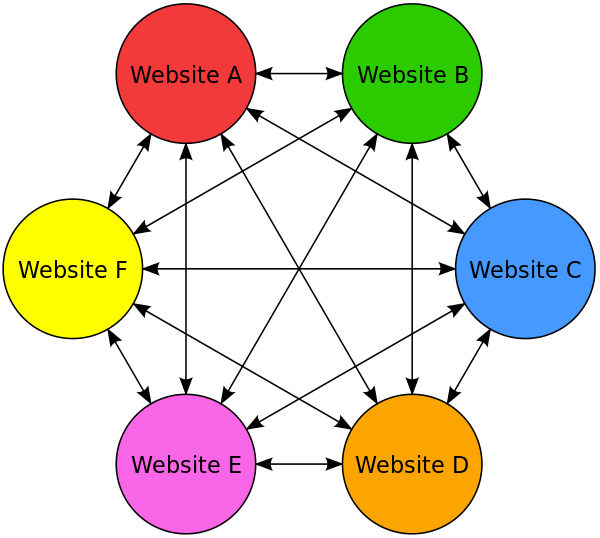
Can you host?
Primarily, websites are stored or hosted on a computer server in a large data center, a large building(s) that houses the servers, with power supply, cooling systems, security, and backups to ensure it stays online faultlessly 24 hours a day, 7 days a week. This internet box, hardware, or server and the site(s) stored within are physically hosted in my living room on a Raspberry Pi 4 running Yunohost. This server is based on "feminist server subcultures provide resources, tools, and support to womxn to learn to use alternatives to proprietary software and build and maintain their own computer networks for further development within broader communities and possibly become (their own) Internet Service Provider (ISP) web server administrator" (A Feminist Server Stack). We each pay for a unique connection to the internet or hosting subscription for our website files, but website hosting is already shared and distributed, "you're sharing resources — like neighbors in an apartment building" (GoDaddy). While today's platform users "expect smooth and seamless on-line experiences" but akin to real-life community spaces running on a shoestring budget, they're rougher around the edges that “explicitly oppose the pleasures and pains of platforms. Possibly they are characterized by their preserving analogue features that make them immune from algorithms and corporate data sharks” (Stuck on the Platform).
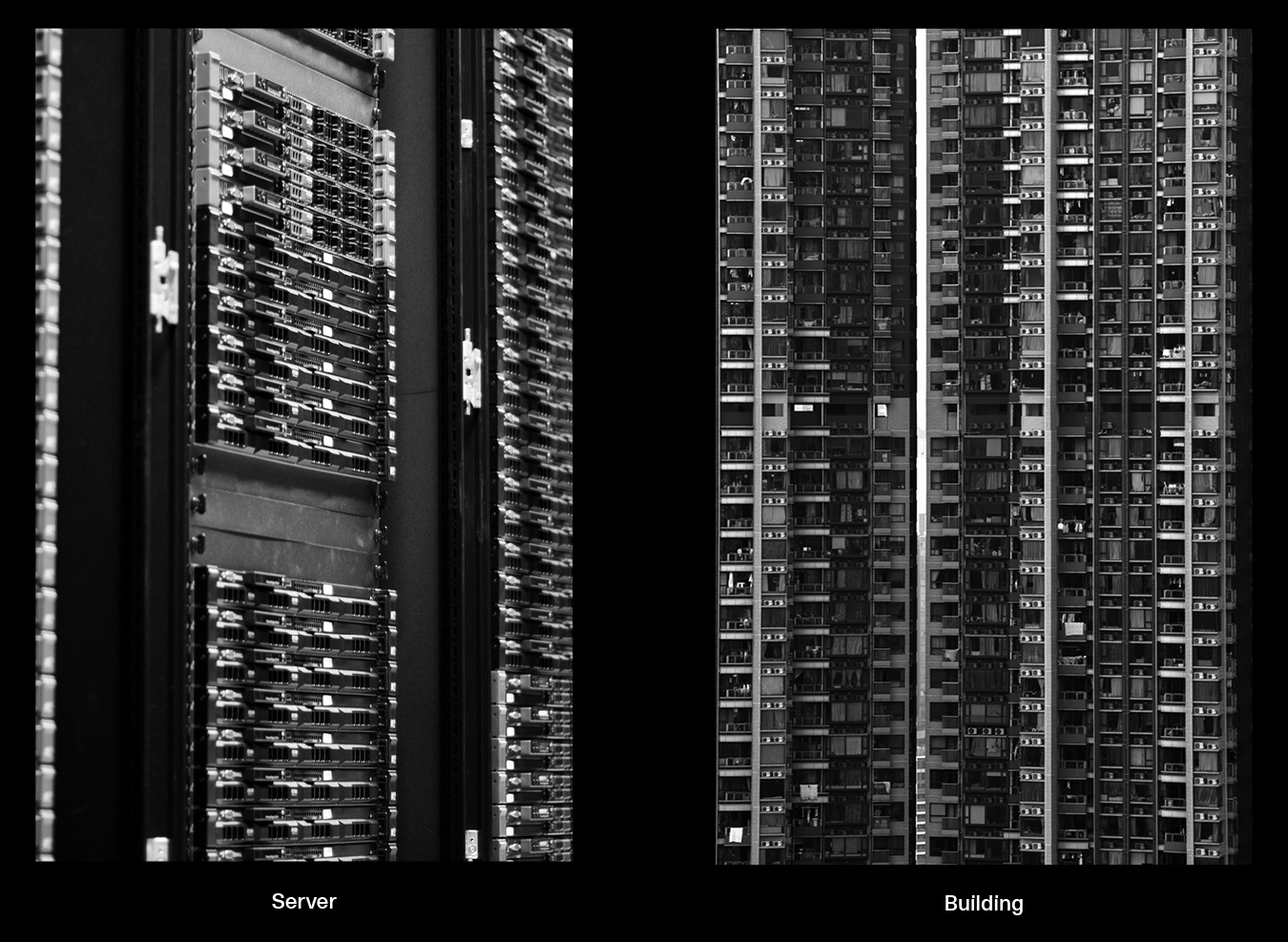
Contact the Webmaster (or become one)
The Webmasters of the early web were generalists; they could design a page, code it in HTML, set up a web server and then upload the files (What Happened to the Webmaster). "Webmasters of the 1990s built homes, worlds and universes. But also, outside of intergalactic ambitions, they strongly pushed the concept of something being mine," that "things can belong to the person who wrote an html code, or scanned pictures, or collected something was unprofitable and dangerous...Will they start to think that the files behind them belong to them? And the day after tomorrow, will they come round to thinking that their data should not be exposed or sold?" (Interface Critique: From My to Me).
Once I've set up the user account or the sub-domain, I will email members their username and password with further instructions on uploading files to the server using an FTP (like Filezilla). Then, members are able to upload their handmade static webpages, HTML, CSS, JS, and media files like JPGs, PNGs, and GIFs.
- Instagram: @em1webmaster
- Website: Strike Design Studio
- Email: info@strikedesignstudio.com
Thank you :) <3
More ~Cool Stuff~